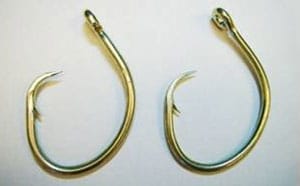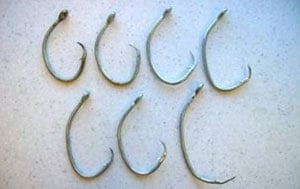
Beginning May 5, commercial longliners fishing for yellowfin tuna, swordfish and other species in the Gulf of Mexico will be required to use a new type of hook, called a weak hook, designed to reduce the incidental catch of Atlantic bluefin tuna.
The Gulf of Mexico is the only known spawning area for the western stock of Atlantic bluefin tuna, and targeting bluefins in the Gulf has been prohibited since the early 1980s. However that hasn’t prevented them from taking longline baits and bluefin are a regular bycatch in the longline fishery. Even when they are released, many bluefin succumb to the stress endured in this incidental capture in warm water.
The weak hook is a circle hook of 3.65 mm round wire, designed to hold smaller fish but straighten under the pressure of larger fish such as the bluefin. The average size of bluefin tuna landed in the Gulf of Mexico longline fishery is 485 pounds, while the average for yellowfin tuna is about 86 pounds.
| Traditional hook, left and weak hook, right, are virtually indistinguishable |

Weak hook, bottom, straightens to release fish under less pressure|
Hooks currently meeting the new requirements are Mustad # 39988D and Eagle Claw L2048ELM, both size 16/O. National Marine Fisheries Service estimates that the weak hook may reduce the bluefin bycatch mortality in the Gulf by as much as 56.5 percent.
“NOAA worked with longline fishermen from the Gulf to test the weak hook carefully over the last three years,” said Eric Schwaab, assistant NOAA administrator for NOAA’s Fisheries Service. “Our cooperative scientific research with fishermen is showing that this new technology can protect bluefin tuna in the Gulf while still allowing fishermen to target yellowfin tuna and swordfish.”
Yellowfin tuna and swordfish are valuable commercial fisheries in the Gulf of Mexico, supporting fishing jobs on approximately 50 vessels as well as jobs on shore. The switch has actually proven beneficial to commercial catch rates.
“During our tests, we used regular hooks for half our hooks and half were the new weak hooks,” said Capt. Mike Carden, a longline fisherman from Panama City, Fla. who took part in the cooperative research. “We were so happy with the weak hooks we quit using the heavy hooks. The weak hook releases fish we don’t want to catch. Because it’s smaller and lighter, we catch more yellowfin tuna on the weak hook.”
By putting the weak hook rule into effect now, NOAA is following recommendations by the International Commission for the Conservation of Atlantic Tunas to extend special protection to the 2003 year class of bluefins. Data indicates this is the largest year class of bluefin since 1974, and estimates are that the number of fish born in subsequent years has been quite low, making protection of this strong year class even more important to long-term rebuilding of the depleted bluefin tuna populations.









